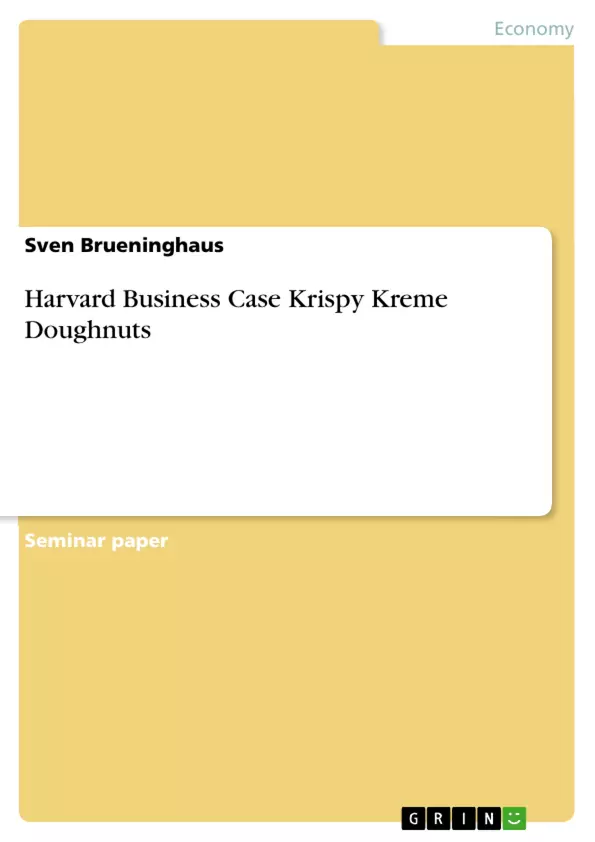Krispy Kreme Doughnut is an American corporation, which started business in
1937 as a small regional company. It developed quite well in the first years but
started it’s big push end of the 90ies. Currently the concept is based on
company stores, which produce doughnuts and sell them to supermarkets and
bakeries but also within the production facilities. To realise the growth of the
past Krispy Kreme offered the business concept as a franchise to interested
entrepreneurs within the whole US. The franchise concept has recently
changed to an area developer concept under which entrepreneurs have the
right to open a defined number stores in a designated area. Krispy Kreme is on
one hand equity stakeholder in the franchises to participate in the positive
results and on the other hand they request royalties from the area developer
and franchisees for every store based on the sales figures. For additional
growth the franchise concept will be replaced by the area developer concept in
the future. The third profit area is the sales of equipment to the area developer
stores, which guarantees a constant quality of the products.
Krispy Kreme Doughnuts went public in April 2000 and had a follow-on public
offering in February 2001. Compared with the development of the S&P 500 the
stock of Krispy Kreme performed much better and won 375% whereas the S&P
500 lost about 20% in the same time period.
The company has ambitious growth plans for the years 2003 and 2004. Based
on these plans of the company, on the business concept, on the opportunities
and on the competitive situation two analysts from CIBC World Markets have
forecasted the business performance and financial situation of Krispy Kreme
Doughnuts in 2003 and 2004. They have developed an Income Statement for
these years; the purpose of this paper now is to analyse this forecast statement
and give the management of Krispy Kreme Doughnuts an advise regarding their
desired financial strategy and on the consequences this strategy might have for
the overall strategy of the company.
Table of Contents
- Introduction
- Growth plans and financial/financing strategy of Krispy Kreme's Management for the following two years
- Analysis of budgeted financial position and performance of Krispy Kreme Doughnuts for 2003 and 2004
- Adjustment of Income Statement for 2001 until 2004
- Analysis of Sales
- Analysis of Expenses
- Analysis of Profit and Earnings
- Summary of analysis
- Liability Structure of the Company
- Advise to the Management about the desired financial strategy and the consequences for the overall strategy of the company
Objectives and Key Themes
This paper analyzes the forecasted financial position and performance of Krispy Kreme Doughnuts for 2003 and 2004, based on the company's ambitious growth plans and the business concept. The analysis aims to provide advice to the management regarding their desired financial strategy and its potential impact on the overall strategy of the company.
- Analysis of Krispy Kreme's growth plans and financial strategy for the following two years.
- Evaluation of the company's financial position and performance for 2003 and 2004.
- Assessment of the company's liability structure and its impact on the financial strategy.
- Recommendation for a desired financial strategy and its implications for the overall business strategy.
Chapter Summaries
- Introduction: The paper introduces Krispy Kreme Doughnuts, its business concept, and its recent growth strategy. The paper also highlights the company's strong stock performance and its ambitious growth plans for the next two years.
- Growth plans and financial/financing strategy of Krispy Kreme's Management for the following two years: This chapter outlines Krispy Kreme's planned store expansion, focusing on the transition from a franchise to an area developer model. The chapter also discusses the company's strategy for financing its growth, relying primarily on proceeds from previous public offerings and operational cash flows.
- Analysis of budgeted financial position and performance of Krispy Kreme Doughnuts for 2003 and 2004: This chapter delves into the analysis of Krispy Kreme's financial performance for 2003 and 2004. The analysis focuses on adjusting the company's income statement, examining sales, expenses, and profit, providing a comprehensive overview of the company's financial health during this period.
Keywords
This paper focuses on analyzing the financial strategy of Krispy Kreme Doughnuts, exploring its growth plans, financial performance, and liability structure. Key terms and concepts include franchise model, area developer, financial forecasting, income statement analysis, and debt financing.
- Citation du texte
- Sven Brueninghaus (Auteur), 2003, Harvard Business Case Krispy Kreme Doughnuts, Munich, GRIN Verlag, https://www.grin.com/document/16546



